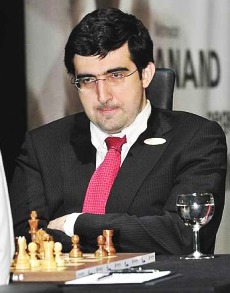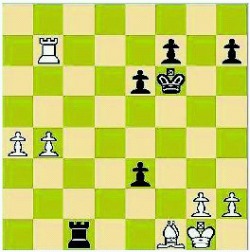Vladimir Kramnik’s game plan at the world championship disintegrates.
THERE’s a great deal of head scratching at the world chess championship between world champion Viswanathan Anand and former world champion Vladimir Kramnik in Bonn, Germany, where Kramnik’s chess game plan seems to be falling apart.
In the championship match, the Indian grandmaster is poised to score a knock-out blow against the Russian any time soon.
 Russian Vladimir Kramnik concentrating during his match against Indian world champion Viswanathan Anand at the chess world championships on Tuesday in Bonn.
Russian Vladimir Kramnik concentrating during his match against Indian world champion Viswanathan Anand at the chess world championships on Tuesday in Bonn.
If you haven’t been able to follow the match on the Internet, Anand won the third and fifth games with the black pieces, and in the sixth game on Tuesday, scored his first victory with white.
It is very likely that the match, which is supposed to stretch until Nov 2, may see an early conclusion should Anand attain the magical 6½ points quickly. Right now, he already has amassed 4½ points, putting him only two points short of the total.
Kramnik, who had high hopes of snatching back the world title crown that he had held previously, is having a major crisis in confidence after suffering his third loss in six of the 12-game match. It’s quite unprecedented for him.
So far, the games have hardly any yawn factor and to the delight of worldwide chess spectators, the two players are having a big duel on the chess board by testing out ideas and variations that both had prepared for this match.
The big question is, why Kramnik is playing like a patzer or a headless chicken, given that playing a match is not an activity alien to him. In world championship match play alone, he had beaten Gary Kasparov in 2000, Peter Leko in 2004 and Veselin Topalov in 2006. So he has plenty of experience.
But in Bonn, Anand is outplaying him in quiet positions (which is supposed to be his strong point) as well as in complicated ones. How can he ever claw his way back into the match?
Maybe a hint of the Indian’s own level of preparation can be gleaned from his own observation: “In a match, you have to deal with a single player but you have to deal with him again and again. So you are supposed to go deep rather than broad. In a match, you cover very few areas but you squeeze the water out of a rock.
“In a match, you get this feeling of being watched. You are thinking of no one but him and he is thinking of no one but you. If you don’t beat the guy, you are not going to win. In a match, you can’t win by half a point.”
In my opinion, the best sites to watch the games are still the Internet Chess Club and PlayChess servers. The moves are relayed almost instantaneously to people who log in. You can also follow the games from the official website at www.uep-worldchess.com/ and although there are multiple mirror sites to choose from, it’s still painfully slow to click and wait.
This week, I’m showcasing the fifth game of the match. It was the second time in five games that the two players had chosen the Meran variation of the Queen’s Gambit, Slav Defence.
White: Vladimir Kramnik (2772)
Black: Viswanathan Anand (2783)
1. d4 d5 2. c4 c6 3. Nf3 Nf6 4. Nc3 e6 5. e3 Nbd7 6. Bd3 dxc4 7. Bxc4 b5 8. Bd3 a6 9. e4 c5 10. e5 cxd4 11. Nxb5 axb5 12. exf6 gxf6 13. 0-0 Qb6 14. Qe2 Bb7 15. Bxb5
(Up to this point, this game has followed the third game which Kramnik lost. In that game, Anand had chosen to reply with 15. … Bd6 and he went on to win but here, he varied by immediately putting his rook into play on the g-file.)

15. … Rg8 16. Bf4 Bd6 17. Bg3 f5
(Of course, Anand avoided exchanging the bishops on the g3 square as it would then end all of Black’s play along this g-file. However, 17. … f5 was a very aggressive move, signalling a no-holds-barred game. Anand could not afford to play quietly and allow Kramnik to reorganise his pieces. If he were to allow that, Kramnik’s pair of distant passed pawn on the queenside could turn into the game winner. For the immediate, Anand’s plan would be to chase the bishop away from g3. Significantly, this aggression also uncovered Kramnik’s level of preparation. He sank into a deep think and thought and thought and thought for about 50 minutes.)
18. Rfc1 f4 19. Bh4 Be7 20. a4 Bxh4 21. Nxh4 Ke7
(The black king frees itself from the pin and his rooks are now connected. It would be time for him to challenge White on the c-file as well.) 22. Ra3 (May not be the best move as later, this rook is forced to return to the back rank.)
22. … Rac8 23. Rxc8 Rxc8 24. Ra1 Qc5 25. Qg4 Qe5 26. Nf3 Qf6 27. Re1
(Anand had set a trap for Kramnik and it would have been a mistake to fall for it. But I suppose Kramnik would have seen and avoided 27. Nxd4? Qxd4 28. Rd1 Nf6.)
27. … Rc5 28. b4 Rc3 29. Nxd4??
(What is this? If Kramnik had avoided the trap two moves earlier, why did he fall for it now? The only plausible reason was that he was already under tremendous pressure on the board and on his clock. When I was watching the game, I saw the next few moves being played very quickly. I think Kramnik thought that he had seen through the sequence but Anand had seen one step deeper.)
29. … Qxd4 30. Rd1 Nf6 31. Rxd4 Nxg4 32. Rd7+ Kf6 33. Rxb7 Rc1+ 34. Bf1
(Possibly on the 29th move, Kramnik thought that this move would avoid the back rank mate but he must have missed Anand’s killer sacrifice.)
34. … Ne3 35. fxe3 fxe3 0-1
(This was the point where Kramnik resigned the game to let Anand go two-up on him. There was nothing that Kramnik could do to prevent 36. … e2 next to attack the bishop. His pair of queenside pawns had advanced but Anand’s pawn on e3 would be more decisive.)
World youth games
Although all chess eyes are focused on Bonn presently, there are other interesting chess events happening elsewhere in the world. On a smaller scale, there is the world youth chess championship that’s now in progress in Vung Tao, Vietnam.
There are almost 900 participants from 73 countries gathered in this Vietnamese seaside town and challenging for the open and girls un-der-18, under-16, under-14, under-12, under-10 and under-8 titles.
Malaysia is represented in this championship by 10 players: Justin Ong (open, under-16), Azhar Muhammad Syakir Shazmeer (open, under-14), Elgin Lee (open, under-12), Aron Teh and Yeoh Li Tian (open, under-10), Alia Anin Bakri (girls, under-14), Nur Nabila Hisham (girls, under-12), Nur Najiha Hisham and Camilia Johari (girls, under-10) and Puteri Rifqah (girls, under-8).
The fight for the open under-18 title is expected to be the most intense with three grandmasters in the 75-player field, two of them being local Vietnamese grandmasters Le Quang Liem and Nguyen Ngoc Truong Son, and the other being David Wei Liang Howell of Britain. The youth championship will end on Oct 30.
